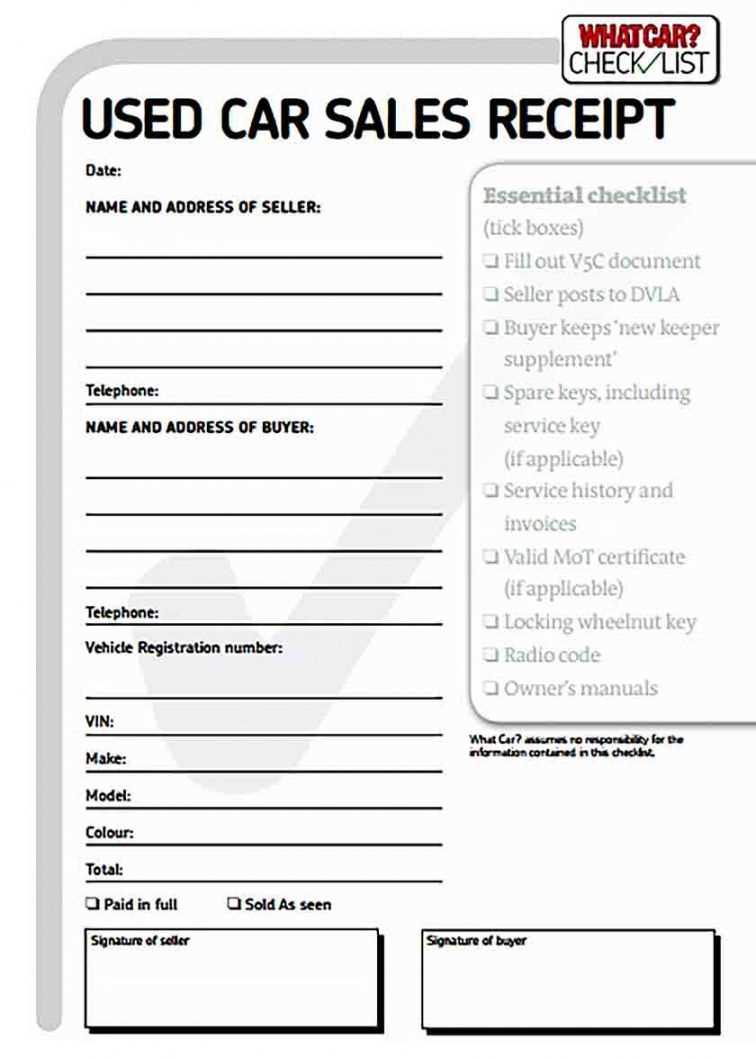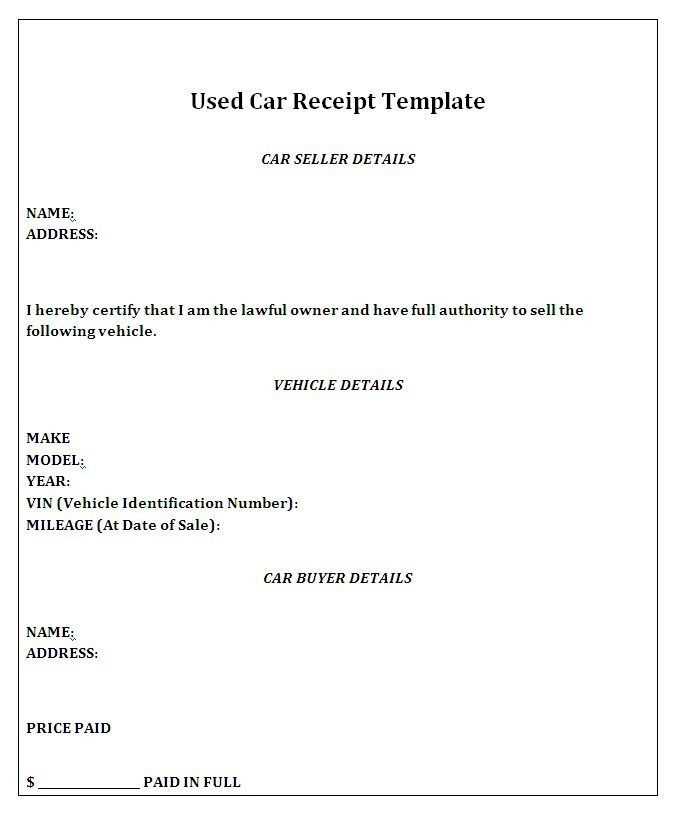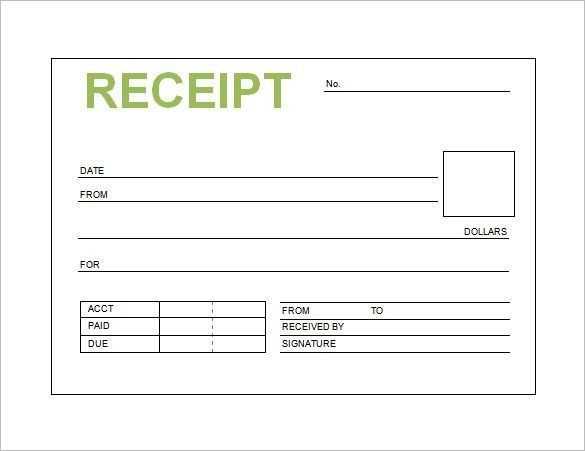
Always provide a written receipt when selling a vehicle privately. This document serves as proof of the transaction and protects both buyer and seller from disputes. A well-structured receipt should include key details such as the vehicle’s make, model, year, VIN, sale price, and the names and signatures of both parties.
Clarity and accuracy are crucial. Ensure that the receipt specifies whether the sale is “as-is” or if any warranties apply. Mention the payment method used and the date of the transaction. If applicable, include an odometer disclosure statement, which is often required by law.
To avoid legal issues, both parties should keep a copy of the signed receipt. Some regions require additional documentation, such as a bill of sale or title transfer form. Check local regulations to confirm any extra steps needed.
A simple, well-organized template makes the process faster and smoother. Below, you’ll find a structured format that covers all necessary details, ensuring a hassle-free private vehicle sale.
Here’s a revised version without excessive repetition of “Receipt”:
Parties Involved: Include the full names and contact details of both the buyer and the seller to avoid confusion.
Vehicle Information: Detail the car’s make, model, year, color, VIN, and current mileage. This ensures all relevant facts are recorded.
Transaction Details: Clearly state the sale price, method of payment, and the date of the transaction. If payment is made in installments, specify the amounts and due dates.
Condition of the Vehicle:

Note whether the car is sold “as-is” without warranties. Be clear about any existing issues or the absence of guarantees from the seller.
Signatures:

Both the buyer and seller should sign the document to acknowledge the terms. Adding printed names next to signatures can help clarify the agreement.
- Private Sale of Vehicle Receipt Template
A private sale of a vehicle receipt should include specific details to protect both the seller and buyer. Ensure the document clearly states the vehicle’s make, model, year, VIN (Vehicle Identification Number), and mileage at the time of the sale. It’s also important to outline the total sale amount, including any deposits or down payments received, as well as the date of the transaction.
Both parties should sign and date the receipt to acknowledge the transaction. In addition, consider adding a statement about the condition of the vehicle, specifying whether it’s being sold “as is” or with any warranties. Include any relevant terms or conditions related to the sale, such as payment method or additional agreements. A clear and detailed receipt helps resolve disputes and confirms the transfer of ownership.
Ensure the receipt includes the following details:
- Vehicle Details: Provide the make, model, year, VIN (Vehicle Identification Number), and odometer reading at the time of sale.
- Seller’s Information: List the full name, address, phone number, and email of the seller.
- Buyer’s Information: Include the buyer’s full name, address, phone number, and email.
- Sale Price: State the agreed sale price in both numeric and written form.
- Date of Sale: Clearly mention the exact date the transaction took place.
- Payment Method: Indicate how payment was made, whether in cash, by check, or through bank transfer.
- Condition of Vehicle: Add a statement regarding the condition of the vehicle at the time of sale, such as “sold as-is” or “no warranties implied”.
- Signatures: Both the buyer and seller should sign and date the document to confirm the transaction.
By including these details, you can create a clear, legally sound record of the vehicle sale.
When selling a vehicle, you must create a record that fulfills legal requirements. Make sure your document includes the following key points:
- Full Names and Addresses: Both buyer and seller must be listed with their full names, addresses, and contact details.
- Vehicle Information: Clearly state the vehicle’s make, model, year, VIN (Vehicle Identification Number), and license plate number.
- Date of Sale: Indicate the exact date the transaction took place.
- Odometer Reading: The mileage at the time of sale must be recorded, along with a statement confirming its accuracy.
- Sale Price: Specify the agreed-upon price, including any taxes or fees, if applicable.
- Signatures: Both parties need to sign the document to confirm the transaction.
- As-Is Clause: If the vehicle is sold “as-is,” include a statement confirming that the seller makes no warranties regarding the vehicle’s condition.
This record is not only a safeguard for both parties but may also be required for vehicle registration and insurance purposes. Keep copies of the signed document for your records.
Begin with clear headings for each section. Use bold text for key details such as the buyer’s and seller’s information, vehicle details, and payment terms. This helps the reader quickly locate the most relevant sections. Ensure that all fields are properly labeled to avoid ambiguity. Use bullet points to list specific items like vehicle features, defects, or any special conditions of the sale.
| Item | Description |
|---|---|
| Buyer Information | Name, address, contact details |
| Seller Information | Name, address, contact details |
| Vehicle Details | Make, model, year, VIN |
| Sale Terms | Payment method, sale price |
Use short paragraphs for readability. Avoid long, dense text that may overwhelm the reader. Make sure each section is concise and to the point, and only include relevant details. Group related information together to maintain logical flow throughout the document.
Lastly, ensure that any legal terms are clearly defined. Use simple language wherever possible to avoid confusion and ensure both parties fully understand the agreement.
Ensure all fields are accurately filled out. Incomplete or incorrect information, such as missing signatures or wrong vehicle details, can make the sale invalid. Double-check the vehicle identification number (VIN) and ensure it matches the one on the registration and title.
Do not leave any blank spaces. If certain sections do not apply, use “N/A” instead of leaving them empty. This helps prevent confusion and ensures all areas are addressed.
Failure to retain copies of the signed paperwork is a common mistake. Both the buyer and seller should have their own copy of the signed receipt. This provides proof of the transaction and protects both parties in case of disputes.
Ensure that both the seller and the buyer complete the required fields. Sometimes, one party may overlook a section, leading to potential problems when the documents are submitted for registration or transfer.
Be clear on the payment method and terms. Vague or unrecorded payment details can lead to misunderstandings later on. If possible, specify the payment method (e.g., cash, bank transfer) and any relevant dates.
If you need a receipt template for a private vehicle sale, you have both printable and digital formats at your disposal. Choose the option that best suits your needs for convenience and record-keeping.
Printable Templates provide a simple, physical record that you can sign and hand over directly to the buyer. These templates can be printed from any computer or printer. For a smooth process, ensure you use high-quality paper to avoid fading or damage over time.
Digital Templates offer the flexibility of emailing the receipt to the buyer. You can store a copy for future reference or print it later if needed. PDF is a popular format for digital templates as it preserves the layout and ensures easy access on any device. You can fill in the details electronically, which speeds up the process and reduces the chance of errors.
Both options have their advantages, but your choice depends on what is most convenient for you and the buyer. If you prefer quick documentation and digital storage, go for the digital template. If you like physical copies for immediate transactions, printable versions are ideal.
Many platforms offer free and customizable templates for private vehicle sale receipts. Websites like Template.net and Jotform provide a range of templates that can be easily tailored to fit your needs. These resources allow you to adjust fields, design, and layout to ensure the receipt reflects the transaction accurately.
Template Websites

Check DocFormats for free templates, where you can download and edit documents in various formats. You can adjust them to suit your sale details, ensuring all necessary information is included, such as buyer and seller details, sale date, and vehicle specifics.
Online Form Builders

If you prefer creating a receipt from scratch, platforms like Google Docs and Canva provide user-friendly design tools. You can easily design a customized template and share or print it directly from their interfaces.
Ensure your vehicle sale receipt is clear and detailed. Begin with a header specifying the sale’s purpose, such as “Private Vehicle Sale Receipt”. Include the vehicle’s make, model, year, and VIN. List the seller’s full name and address, along with the buyer’s details. Clearly state the agreed sale price and the payment method. Mention if any warranties or guarantees are included or waived. Lastly, include both parties’ signatures and the sale date to validate the document.
This simple structure ensures both the buyer and seller have a clear understanding of the transaction details. A well-documented receipt protects both parties in case of any future disputes.


